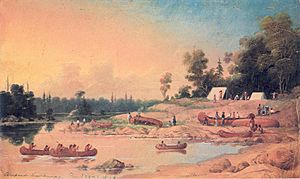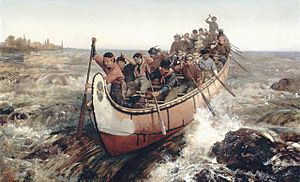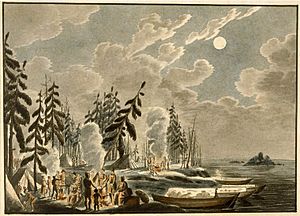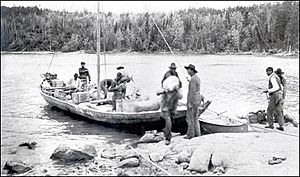Fur brigade facts for kids
Fur brigades were like convoys of canoes and boats that moved supplies, trading goods, and furs across North America. This was a huge part of the North American fur trade, a big business long ago. Many of the people involved were Native fur trappers, especially the Métis people. These brigades traveled between smaller trading posts and bigger posts run by companies like the Hudson's Bay Company or the North West Company. They brought goods to the inland posts and furs back to the main posts near the coast.
Most of the time, these journeys happened on rivers using canoes. But in some flat, grassy areas, people used horses instead. For example, they might travel all the way to Hudson Bay or James Bay from their homes far inland. This way of traveling was most common in the early 1800s. Over time, canoes were replaced by bigger, stronger York boats. These boats were better because they could carry more and were more efficient.
Canoe Brigades: Traveling by Water

Fur brigades started because people needed a way to move furs caught in the winter to places where they could be traded for European goods. At first, small groups of Native canoes would travel to meet fur traders at special meeting spots. Later, traders began going out in canoes to meet the trappers in their home areas. This led to the building of forts and trading posts along the way.
One common type of fur brigade used canoes. These were often paddled by skilled voyageurs and other workers. When they traveled downstream, for example, to York Factory on Hudson Bay or to Montreal on the St. Lawrence River, their canoes were mostly filled with furs. When they traveled upstream from these big posts, they carried trading goods. They also brought things like ammunition, traps, and other supplies needed for the next winter's trapping season. These trips usually happened once a year.
These Canadian canoe routes became a huge transportation network for the North American fur trade. Supplies, trading goods, and furs were moved between many forts and posts. The furs were then shipped every year to markets all over the world.
York Boats: Bigger and Stronger
In the 1790s, York boats were invented to solve problems with canoes. Canoes were easily damaged, couldn't carry much, and needed many paddlers. York boats were a better choice because they were tough, could hold a lot of cargo, and didn't need as many people to operate them. This helped the Hudson's Bay Company move people and goods across Canada much more easily. While the company's leader, George Simpson, sometimes used canoes for his own trips, York boats quickly became the main way to travel.
York boats were built by finding good wood in forests. This wood was floated to trading posts on waterways. Then, it was cut into parts like keels (the bottom of the boat), planks, stems (front and back parts), and gunnels (top edges). Trading posts often had special areas just for building these boats. York boats looked a lot like Orkney Isles fishing boats. This was probably because many men working for the Hudson's Bay Company came from the Orkney Islands. These boats usually traveled in brigades, carrying supplies and trading goods.
By the 1820s, the Hudson's Bay Company had several York boat brigades traveling on different routes. They had built permanent trading posts at important spots along these main routes. As soon as the ice melted on the waterways, the fur brigades would set out. They carried trade goods and food to restock the trading posts. On their return trip, they picked up all the furs that had been collected during the winter. They also carried mail and passengers.
Most of the crews for these boat brigades were Métis people. In fact, almost all the men working for the Hudson's Bay Company in western Canada at that time were Métis. For example, in 1862, the York boats from the Red River area were crewed by French Métis, along with some Swampy Cree and Chippewa Christians.
The crews of some of these fur brigades had fun nicknames, sometimes based on what they ate!
- The Red River "tripmen" were called the Taureaux, which means "bulls." A "Taureau" was also a bag of pemmican (a type of dried meat) weighing about 90 pounds.
- The Portage La Loche brigade's tripmen were called the Poissons-blancs, meaning "whitefish."
- The Saskatchewan River brigade, based in Fort Edmonton, were called the Blaireaux, meaning "badgers."
- Les Cygnes (the swans) were from the Swan River district, based in Fort Pelly.
- Les Rabasca (Athabascans) were from the Athabasca district, based in Fort Chipewyan.
- Les Gens de la Grande Riviere (men of the great river) were from the Mackenzie River district, based in Fort Simpson.
These brigades were very competitive! They would often have friendly fistfights between their "champions" to defend their brigade's honor. A challenger would show off, wearing feathers in his cap and bragging about his strength.
Famous Brigades
- Portage La Loche Brigade
- York Factory Express





